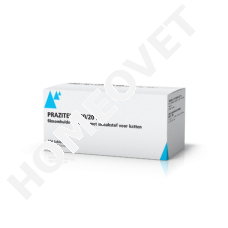Prazitel Plus Worming Tablets for Cats
Prazitel Plus flavoured Tablets for Cats are for the treatment of cats with mixed infections of nematodes and cestodes, including Ascarids, Hookworms, Whipworms and Tapeworms. One tablet per 4 kg bodyweight.
Prazitel 230/20 mg Flavoured Tablets for Cats
Prazitel Plus Tablets for Cats are for the treatment of cats with mixed infections of nematodes and cestodes, including Ascarids, Hookworms, Whipworms and Tapeworms.
Meat Flavoured Tablets. One tablet per 4 kg (approx. 9 lb) body weight. Can be given with or without food. Contains: 20 mg praziquantel, 230 mg pyrantel embonate per tablet . The tablet can be divided into equal halves.
Target species; Cats.
Indications for use, specifying the target species;
- For the treatment of mixed infections caused by the following gastrointestinal roundworms and tapeworms:
- Roundworms: Toxocara cati, Toxascaris leonina,
- Tapeworms: Dipylidium caninum, Taenia taeniaeformis, Echinococcus multilocularis.
Contraindications;
- Do not use simultaneously with piperazine compounds.
- Do not use in kittens less than 6 weeks of age.
- Do not use in animals with known hypersensitivity to the active substances or to any of the excipients.
Special warnings for each target species;
Fleas serve as intermediate hosts for one common type of tapeworm – Dipylidium caninum. Tapeworm infestation is certain to reoccur unless control of intermediate hosts such as fleas, mice, etc. is undertaken.
Parasitic resistance to a certain class of anthelmintics can occur after frequent and repeated use of an anthelmintic from this class.
Special precautions for use;
Special precautions for use in animals;
Not applicable.
Special precautions to be taken by the person administering the veterinary medicinal product to animals;
- In the interests of good hygiene, persons administering the tablets directly to the cat, or by adding them to the cat’s food, should wash their hands afterwards.
- In case of accidental ingestion, seek medical advice and show the package leaflet to the physician.
Adverse reactions (frequency and seriousness);
None known.
Use during pregnancy, lactation or lay;
Do not use during pregnancy but may be used during lactation.
Interaction with other medicinal products and other forms of interaction;
Do not use simultaneously with piperazine compounds.
Overdose (symptoms, emergency procedures, antidotes), if necessary
After doses higher than 5 times the recommended dose, signs of intolerance such as vomiting have been observed.
Pharmacodynamic properties;
This product contains anthelmintics active against gastrointestinal roundworms and tapeworms. The product contains two active substances, as follows:
Pyrantel embonate (pamoate), a tetrahydropyrimidine derivative and Praziquantel, a partially hydrogenated pyrazinoisoquinoline derivative.
Pyrantel acts as a cholinergic agonist. Its mode of action is to stimulate nicotinic cholinergic receptors of the parasite, induce spastic paralysis and thereby allow expulsion from the gastro-intestinal (GI) system by peristalsis.
Praziquantel is very rapidly absorbed and distributed throughout the parasite. Both in vitro and in vivo studies have shown that praziquantel causes severe damage to the parasite integument, resulting in contraction and paralysis. There is an almost instantaneous tetanic contraction of the parasite musculature and a rapid vacuolization of the syncytial tegument. This rapid contraction has been explained by changes in divalent cation fluxes, especially calcium.
In this fixed combination, pyrantel is active against the following ascarids: Toxocara cati, and Toxascaris leonina. Praziquantel is effective against tapeworms in particular Dipylidium caninum and Taenia taeniaeformis.
Since it contains praziquantel, the product is effective against Echinococcus multilocularis,.
Pharmacokinetic particulars;
Praziquantel is rapidly absorbed, metabolised and distributed in the body. It is also believed to be excreted back into the intestinal lumen by the mucous membrane.
Following administration of the product to cats, peak plasma concentrations of praziquantel were achieved by approximately 2 hours.
Pyrantel is poorly absorbed so it is expected that a large proportion of the administered dose remains in the GIT where it exerts its therapeutic effect and it is excreted largely unchanged in the faeces.
Following administration of the product to cats, peak plasma concentrations of pyrantel were achieved by approximately 3 hours.
Incompatibilities;
Not Applicable
Special precautions for storage;
This veterinary medicinal product does not require any special storage conditions
Special precautions for the disposal of unused veterinary medicinal products or waste materials,
Any unused veterinary medicinal product or waste materials derived from such veterinary medicinal product should be disposed of in accordance with national/local requirements.
Administration and duration of treatment
Single oral administration. The tablet should be given directly to the cat, but if necessary can be disguised in food.
In ascarid infestation, especially in kittens, complete elimination cannot be expected, so a risk of infection for humans can persist. Repeat treatments should, therefore, be carried out with a suitable roundworm product at 14 day intervals until 2-3 weeks after weaning. Amounts to be administered and administration route;
To ensure administration of a correct dose, body weight should be determined as accurately as possible.
Dosage; The recommended dose is: 20 mg/kg pyrantel (57.5 mg/kg pyrantel embonate) and 5 mg/kg praziquantel. This is equivalent to 1 tablet per 4 kg bodyweight.
Dosage Guide*, Weigh animals before treatment. (Do not use in kittens less than 6 weeks of age.)
Bodyweight Dosage
1.0 – 2.0 kg ½ tablet
2.1 – 4.0 kg 1 tablet
4.1 – 6.0 kg 1 ½ tablets
6.1 – 8.0 kg 2 tablets
Discard unused half tablets.

 HOME
HOME OFFERS
OFFERS NEW PRODUCTS
NEW PRODUCTS SHIPPING COST
SHIPPING COST

